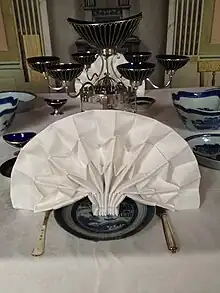
Napkin folding is a type of decorative folding done with a napkin. It can be done as art or as a hobby. Napkin folding is most commonly encountered as a table decoration in fancy restaurants.[1] Typically, and for best results, a clean, pressed, and starched square cloth (linen or cotton) napkin is used.[2] There are variations in napkin folding in which a rectangular napkin, a napkin ring, a glass, or multiple napkins may be used.
History
The earliest instruction manual for the artistic folding of napkins was published in 1639 by Matthia Gieger, a German meat carver working in Padua, as a part of a series of treatises on culinary arts titled Le tre trattati.[3] Napkin folding has a centuries-old history[4] and dates back to the times of Louis XIV of France (5 September 1638 – 1 September 1715), known as Louis the Great (Louis le Grand) or the Sun King (le Roi-Soleil), who ruled as King of France from 1643 until his death.[5] The shift of the napkin from simply a folded cloth to a folded art object occurred in the 16th century in Florence, Italy around the same as voluminous clothing, such as ballooned sleeves, had become fashionable among the wealthy.[6] Rather than simply laying a tablecloth flat on a table, starched linens were folded into large centerpieces, called "triumphs," that could depict a variety of real and mythical animals, natural elements and architectural forms.[6] A popular gift wedding guests received during this time was a personally folded napkin that distinguished whether they were related to the bride or groom.[6] In the mid-18th century, table setting practices were so specific that in Germany there were particular traditions on how to fold napkins, display figures at the table and arrange plate.[7] During this golden age of napkin folding, there was a school in Nuremberg devoted entirely to this art and butlers had shelves of instructional books to keep up with the changes in the field.[3] Napkin folding in the form of table sculptures began being replaced by porcelain decorations during the 18th century.[3]
Common napkin folds

- Bishop's Hat
- Buffet fold (rectangular pocket)
- Candle
- Diagonal pocket
- Dress Shirt
- Envelope
- Fan
- Fleur-de-lis
- Iris
- Lotus (water lily)
- Rose
See also
References
- ↑ Kuhn, Doris (2005). Napkin Folding for Every Occasion. New York: Sterling Publishing. p. 9. ISBN 9781402728020. "It is no accident that fine restaurants have long preserved the art of napkin folding as an important element of presentation."
- ↑ "Napkin Folding Ideas". Marthastewart.com. Retrieved 2013-05-07.
- 1 2 3 "The History and Techniques of Napkin Folding". www.ediblegeography.com. Retrieved 2016-09-29.
- ↑ Hetzer, Linda (2001). The Simple Art of Napkin Folding: 94 Fancy Folds for Every Tabletop Occasion. Robert Penny (1st William Morrow pbk. ed.). New York, N.Y.: William Morrow. p. 7. ISBN 9780060934897. Retrieved 26 February 2013. "More than three centuries ago, napkin folding was developed into an art, ..."
- ↑ Kuhn, Doris (2005). Napkin Folding for Every Occasion. New York: Sterling Publishing. pp. 9–10. ISBN 9781402728020.
- 1 2 3 "Unfolding The History Of Napkin Art". NPR. Retrieved 2016-09-29.
- ↑ Tattersall, Bruce. "Table Services and Ornament". Oxford Art Online. Grove Art Online.
Further reading
- Kuhn, Doris (2005). Napkin Folding for Every Occasion. New York: Sterling Publishing. ISBN 9781402728020.
- Oppenheimer, Lillian; Epstein, Natalie (1979). Decorative napkin folding for beginners. New York: Dover Publications. ISBN 0486237974.
- Stislow, John; Stislow, Stephanie (2008). The Best Napkin Folding Book Ever!: Add Easy Style to Any Meal. New York: Sterling Publications. ISBN 9781435104143